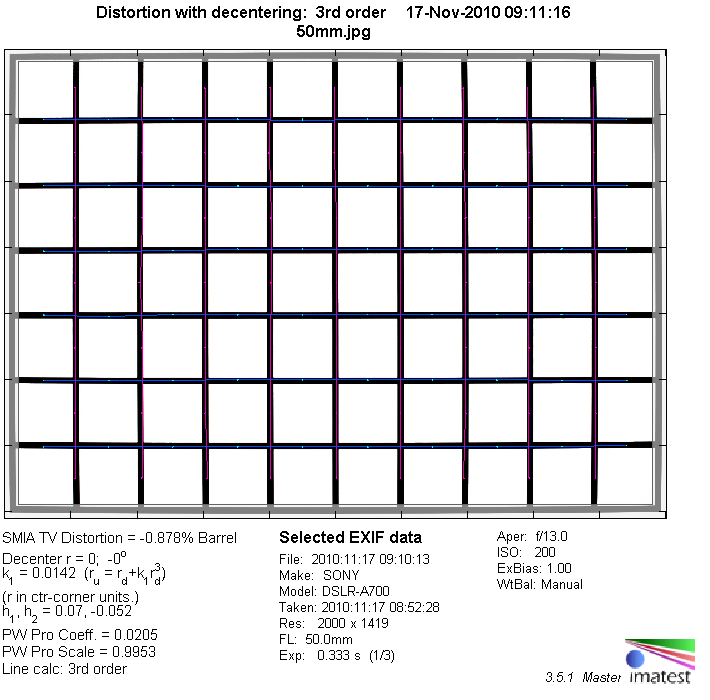|
Sony 50mm f/1.8 DT ( SAL-50F18 ) - Lab Test / Review - Analysis |
|
Lens Reviews -
Sony Alpha/NEX (APS-C)
|
|
Page 2 of 2

Distortion
The Sony lens produces a slight amount of barrel distortion (~0.9%). This is usually not relevant in field conditions anymore.

Vignetting
The 50mm f/1.8 covers the APS-C image circle only. Thus it produces a comparatively high amount of vignetting. At f/1.8 it exceeds 1.1EV which will be visible in some scenes. However, stopping down to f/2.2 resolves most of the issue and it's not really relevant anymore from f/2.8 onwards.

MTF (resolution)
The Sony lens was capable of delivering a very high resolution throughout the tested aperture range. The center performance is already excellent straight at f/1.8 and the contrast level is also very snappy here already. The borders/corners are good to very good till about f/2.8. The edge to edge quality increases at f/2.8 and it reaches its excellent - if not outstanding - peak around f/5.6. The field curvature is marginal.
Please note that the MTF results are not directly comparable across the different systems!
Below is a simplified summary of the formal findings. The chart shows line widths per picture height (LW/PH) which can be taken as a measure for sharpness.
If you want to know more about the MTF50 figures you may check out the corresponding Imatest Explanations
p>
Chromatic Aberrations (CAs)
Lateral chromatic aberrations (color shadows at harsh contrast transitions) are basically non-existent. This adds to the high sharpness perception of the lens.

Bokeh
Out-of-focus highlights show a slight outlining effect as well as a vignetting effect (cat's eyes) at very large apertures. This improves when stopping down to f/2.8 and beyond where the highlights are more uniform and circular. The blur in the critical focus transition zone is pretty smooth and buttery.

Bokeh Fringing / Longitudinal Chromatic Aberrations (LoCA)
Bokeh fringing is a common problem among large aperture lenses and the Sony 50mm f/1.8 DT is no exception to the rule here. It is easily possible to spot purple halos in front and green halos beyond the focus point. The issue does gradually improve
when stopping down but there're still visible traces at f/5.6. To be fair - this is rather typical for such ultra-large aperture lenses.
Verdict
The Sony 50mm f/1.8 DT ( SAL-50F18 ) is pretty much a no-brainer for Sony APS-C DSLR users. The lens is very sharp even at f/1.8 and the resolution is about as good as it gets around f/5.6. Lateral CAs are absolutely negligible which adds to the outstanding sharpness perception. The lens produces a slight amount of barrel distortion but it's not really field-relevant. Typical for a dedicated APS-C format lens it shows rather significant vignetting at f/1.8. The quality of the bokeh is generally very good although out-of-focus highlights suffer somewhat from vignetting effects at large apertures. The bokeh fringing is pronounced at large aperture and the issues dissolves only gradually when stopping down. The Sony 50mm f/1.8 DT is a budget lens and it's most obvious in its build quality - it is a plastic lens down to the mount. That's nothing bad per se but the quality doesn't feel overly reassuring. The new build-in SAM drive is an improvement over the conventional screw-driven AF. The AF accuracy seems to have improved quite a bit but we haven't really noticed an advantage in terms of AF speed or noise. However, these are all minor disadvantages when taking the extremely low pricing into account.
|